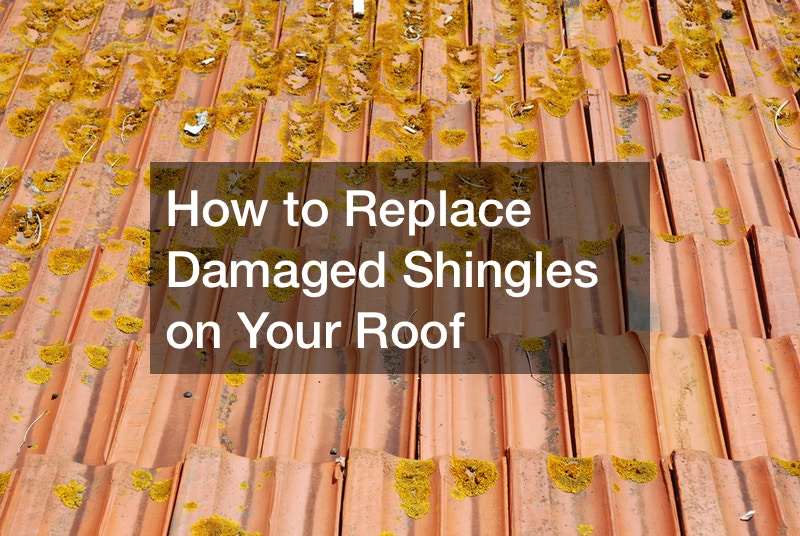
Every homeowner desires to install a long-lasting roof that keeps the household warm and dry with little to no maintenance requirements. However, unfortunate events may occur that necessitate you to either replace or repair the damaged roof shingles. If left unattended, damaged roof shingles can significantly reduce the lifespan of your roof.
Fortunately, there are some tips you can use to replace the damaged shingles on your roof and save expenses on a complete roof shingle installation. However, before you get to the repair and replacement stage, you need to understand what roof shingles are.
What Are Roof Shingles?

Roof shingles are a roof covering the edge of pitched roofs and are laid to overlap. They come in various materials such as metal, plastic, and wood. They contain weather-proofing characteristics that protect your roof from environmental damage.
Types of Roof Shingles
There are various roofing options to choose from depending on the area one lives. It is recommended that you keep the structural integrity of your roof when installing roof shingles to get the best out of them. Some of the commonly used roof shingles are:
Asphalt shingles
These are some of the most common roof shingles because of their waterproof and fireproof capabilities. They are also easier to replace because they are lightweight.
Wood shingles
This type of roof shingles come from trees and are mostly used for aesthetic purposes. The roof shingles can come in the form of cedar, pine, or spruce, depending on the homeowner’s choice.
Metal Shingles
These roof shingles are considered the most efficient due to their reflection and absorption properties. As a result, homeowners can save plenty of costs, especially in the installation of heating and cooling systems.
What are the Advantages of Having Roof Shingles?
Although roof shingles come in various designs and are made up of different materials, they serve more than just aesthetic purposes.
Climatic reasons – different areas have different climatic conditions that will require the home owners to select a roof capable of protecting them in extreme weather conditions. For instance, areas where heavy winter is experienced, would benefit from metal roofing, as it would allow the snow to slide off easily without damaging the roof.
Energy efficiency – In very cold areas, home owners prefer to use solar shingles to maximize energy. Solar shingles are a great addition to such areas due to their ability to withstand heavy wind.
Cosmetic reasons – while others prefer to install roof shingles to protect their roofs and extend durability, some people prefer to use roof shingles as decorative pieces. Roof shingles come in various designs and colors that one can choose from to fit their taste. Wood shingles are popular in adding the aesthetic touch as the wood can be crafted to various designs and give the antique or rustic look.
Causes of Roof Shingles Damage
Maintaining the infrastructure of a building is not an easy task. However, some critical areas, such as the roof, require essential care. Defective roofs can be the cause of unexpected expenses and lead to unforeseen additional problems in the house if left unaddressed.
Several reasons can weaken your roof and cause damage to your roof shingles. Therefore, it is advisable to inspect your roof regularly to detect any issues in their initial stages before they blow up and become major problems. Any leaks, cracks, or curled roof shingles are a cause for alarm and should be attended to immediately. Some of the common reasons for damaged shingles include:
Weather damage – hail, snow, and wind are known to be the major causes of damage to roof shingles. Wind weakens the roof shingles and disturbs the stability of your roof, while snow and hail storms have the capacity of causing water leaks leading to rotting of the roof shingles. In such a situation, you will find yourself asking how to replace damaged shingles on your roof. It is advisable to do the recommended shingle roofing as per the climatic conditions of the area.
Poor installation – Installations, replacements, and repairs should all be done by a professional roofing specialist. If you choose to replace roof shingles on your own without the required skills, you risk damaging the roof or repairing the shingles all over again in a short period. A roof specialist is not only licensed and knows how to replace damaged shingles on your roof but also guarantees the durability and security of the roof. The specialist will also advise you on the recommended roof shingles for your house, how to properly care for them, and extend their durability to prevent regular repairs and replacements.
Replacing Damaged Roof Shingles

There is a lot you can do to maintain your roof shingles. Still, some unavoidable situations could cause damage to your roof shingles. Mother Nature is quite unpredictable, and you may find yourself needing a roof repair or replacement. If you ever find yourself in such a situation, we have outlined some steps to help you on how to replace damaged shingles on your roof with ease.
Step One: Determine the Extent of Damage
When you are conducting the regular maintenance of your roof, you need to establish whether the extent of damage will require a roofing specialist or it is a minor issue that you can handle yourself. If you have no information on how to replace damaged shingles on your roof, seek the services of a specialist to prevent further damage to your roof. Sometimes the damage is minimal, and you can do it yourself or find videos online on how to replace damaged shingles on your roof. For instance, if you discover algae or moss on your roof, there is no need to contact the local roofing services. You can handle this small issue by simply washing roof shingles. With water and bleach, you can wash your roof shingles to get rid of the algae. Ensure that you do light washing to get the algae off the roof and extend the lifespan of your roof.
If the damage is significant, you may want to consider seeking the services of a remodeling company to help you come up with a new roof and shingles installation. In such cases, you might find that the roof installation was probably performed by inexperienced contractors or was not suitable for the climatic conditions. Replacement of the entire roof and roof shingles can be quite costly. PVC roofing is the go-to option for most residential roofing owing to its environment friendly nature, durability, and affordability features.
Step Two: Assemble the right tools
Replacing damaged roof shingles requires some tools to help you perform a good job. If you are able to do it yourself, you will require a hammer, roofing nails, a utility knife, and a flat pry bar, amongst other tools. The extent of the damage will let you know whether you require additional tools such as adhesives, cement, or new roof shingles. You could make use of the remaining roof shingles that were left when they were installed if they are still available. If you need to purchase new shingles, it is advisable to buy more than you need. You may break more shingles while removing or discover more that need replacement as you go by. Although you may have the right tools, you may lack the skills to safely remove and replace the roof shingles. If you are not sure how to replace damaged shingles on your roof, you need to contact local roof replacement services to avoid further damage and incur more costs. They have a team of specialists who can assess the extent of damage and come with the right tools to safely remove and replace the roof shingles at an affordable cost.
Step Three: Observe Safety Precautions
Given that roof shingles are found at the top of the house, one major step on how to replace damaged roof shingles on your roof is to practice safety. Always use a stable and secure ladder when climbing up the roof, as it is quite a distance from the ground to prevent falling. You will need to wear appropriate attire such as gloves, non-slipping shoes or boots, and protective eyewear. You can also include a harness to secure yourself while on the roof. When replacing the damaged shingles, you will need roof jacks to stand on as you work on the roof.
Step Four: Replace Damaged Shingles in Favorable Weather

Replacing the shingles can be a time-consuming task, especially if you want to get it right. Hence, it is recommended you do the job on a weather conducive day. There is no point in trying to replace your roof shingles on a rainy day or an extremely hot day. There exist different types of roof shingles that become moldable in hot weather, which may cause difficulties in removing them. Metal roof shingles can get heated up quickly and are difficult to handle in hot weather. Therefore, it is best to work in conducive weather to make your work easier and prevent further damage to the roof shingles.
Step Five: Remove the Damaged Shingles
A top tip on how to replace damaged shingles in your roof is to remove the damaged ones carefully. Roof shingles are installed by overlapping each other and fastened using nails or adhesive. It is important that you understand their arrangement before removing them. You do not want to end up damaging perfectly fine roof shingles because you carelessly removed them. Carefully remove the nails and pull back the shingles down the slope of the roof. Pulling them down ensures you do not cause a bulge in the roof or damage other perfectly fine shingles.
Step Six: Install the new Roof Shingles
Once you have removed the damaged shingles, one way to replace damaged shingles on your roof is to put an exact match on the shingles. First, ensure that they are leveled and fit in the same position. Once they are in place, secure them with the roofing nails or adhesive, depending on the type of roof shingles you are using. Failure to replace damaged shingles in their exact position could lead to water leaks and cause more damage to the roof.
Step Seven: Secure Loose Shingles
While you are up there making repairs, there is no harm in checking on the rest of the shingles to ensure they are all secure. It is better to be safe than sorry. Removal of the damaged shingles could have loosened other shingles. Hence, it is recommended you check on areas that have the potential of causing problems in the future. Keep a close eye on curled or cracked shingles as these may allow water leakages. You can gently lift the tabs and secure them again using adhesive. It is much better to repair than making replacements as curled shingles allow water to go underneath, causing rot and decreasing the roof’s lifespan.
Step Eight: Final Checkup

Go back a day later after replacing your roof shingles. Monitoring is a major step on how to replace damaged shingles on your roof. Everyone wants to know whether they did a good job or if the roof specialist performed their duties well. Check for any leaks and walk gently on the roof to see whether the replaced shingles are strong enough.
Roof shingles are a perfect addition to your roof, and with the right maintenance, they can last you for a long time. Regularly checking for cracks and curled shingles will not only extend their life and minimize replacement but also save you on additional repair and replacement expenses.
Keep in mind the safety precautions when replacing your roof shingles to avoid any accidents or additional damage to the existing shingles.




